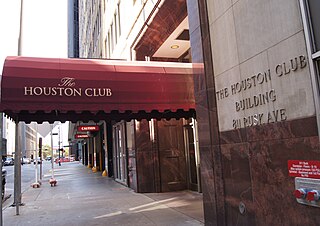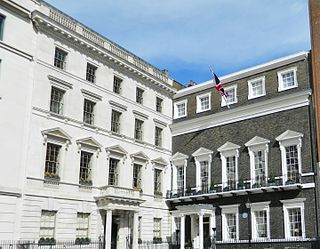
A gentlemen's club is a private social club of a type originally set up by men from Britain's upper classes in the 18th and succeeding centuries.

Chelsea Arts Club is a private members' club at 143 Old Church Street in Chelsea, London with a membership of over 3,800, including artists, sculptors, architects, writers, designers, actors, musicians, photographers, and filmmakers. The club was established on 21 March 1891, as a rival to the older Arts Club in Mayfair, on the instigation of the artist James Abbott McNeill Whistler, who had been a member of the older club.
The Hong Kong Club is a gentlemen's club in Hong Kong, the first in the city. Opened on 26 May 1846, it is a private business and dining club in the heart of Central, Hong Kong. Its members were among the most influential people in the city, including such personalities as senior government officials, senior local businessmen, the heads of the major trading firms, and many legal and accounting professionals. It was often referred to simply as "The Club". The club's first premises were situated on Queen's Road at the junction with D'Aguilar Street.

The Naval and Military Club, known informally as The In & Out, is a private members' club located in St James's Square, London. It was founded in 1862 for officers of the Navy and Army. It now also accepts female members, and members who have not served in the armed forces, but continues to observe service traditions.

A social club may be a group of people or the place where they meet, generally formed around a common interest, occupation or activity. Examples include book discussion clubs, chess clubs, country clubs, final clubs, fishing clubs, gaming clubs, women's clubs, gentlemen's clubs, hunting clubs, military officers' clubs, political clubs, religious clubs, science clubs and university clubs. The term can also refer to a criminal headquarters, such as the Ravenite Social Club or the Cage.

The Oxford and Cambridge Club is a traditional London club. Membership is largely restricted to those who are members of the universities of Oxford and Cambridge, including men and women who have a degree from or who are current students of either university.
The United University Club was a London gentlemen's club, founded in 1821. It occupied the purpose-built University Club House, at 1, Suffolk Street, London, England, from 1826 until 1971.
The Alpine Club was founded in London in 1857 and is the world's first mountaineering club. The primary focus of the club is to support mountaineers who climb in the Alps and the Greater Ranges of the world's mountains.

St Stephen's Club was a private member's club in Westminster, London, founded in 1870.

Den Norske Klub is a social club based in London. It was founded on 17 May 1887. Its members are Norwegians living in London or Britons with a connection to or interest in Norway. It is the oldest club of its kind in the UK and is still an important meeting place for the Norwegian community in London.

The Anglo-Belgian Club was a private members' club located in Northumberland Avenue, London.

The St James's Club was a London gentlemen's club which operated between 1857 and 1978. It was founded by two leading diplomats and its members continued to be largely diplomats and authors. It was first established in Charles Street and moved to 106 Piccadilly by 1868. In the final quarter of the twentieth century many gentlemen’s clubs of London suffered from declining membership, and in 1978 the St James's Club merged with Brooks's Club and vacated its premises.

The Gresham Club was founded in 1843 and dissolved in 1991. It was named after Thomas Gresham. The Gresham Club's last site was located on Abchurch Lane off King William Street before it was sold to the London Capital Club, which in turn ceased operation in 2018. Following the closure of the London Capital Club, a number of the members relaunched The Gresham Club in 2018 and recreated the raison d'être of its original predecessor.
The City University Club is a gentlemen's club in the City of London, established in 1895. From its foundation until 2018 it operated from the top three floors of 50 Cornhill, of what was Prescott's Bank, a 1766 private bank which became a branch of part of the NatWest banking group. This arrangement was quite specifically intended by and between the bank's partners and the club of which they were founding members when the building was designed. The branch closed in 1999 and was turned into a pub of the Fullers chain.

The Green Room Club was a London-based club, primarily for actors, but also for lovers of theatre, arts and music. It was established in 1877 in a restaurant in Piccadilly Circus, and moved to premises on Adam Street in 1955, where it remained until its closure in 2004.

The Athenaeum is a private members' club in London, founded in 1824. It is primarily a club for men and women with intellectual interests, and particularly for those who have attained some distinction in science, engineering, literature or the arts. Humphry Davy and Michael Faraday were the first chairman and secretary and 51 Nobel Laureates have been members.

The Bachelors' Club was a London gentlemen's club in the late nineteenth and early twentieth century, now defunct. As the name suggests, membership was only open to bachelors. The club had a reputation for having a markedly younger membership than many other Edwardian clubs, and given the high-spirited antics which sometimes ensued on the premises, it was cited as an influence on the fictional Drones Club, in some of P.G. Wodehouse's earlier stories. A persistent rumour circulated throughout its existence, and reached wider circulation in the 1920s, that some of its membership were gay - then both illegal and publicly frowned upon – and it soon became superseded by Buck's as the young man's club in London, being forced to close shortly thereafter.

The Public Schools Club is a former London gentlemen's club.

The Junior Athenaeum Club was a gentlemen's club in Piccadilly, London, from 1864 to the 1930s, with similar aims to the Athenaeum Club.

Fiona Scott Lazareff is an activist and has created various campaigns to support social justice and women's entrepreneurship in technology.















